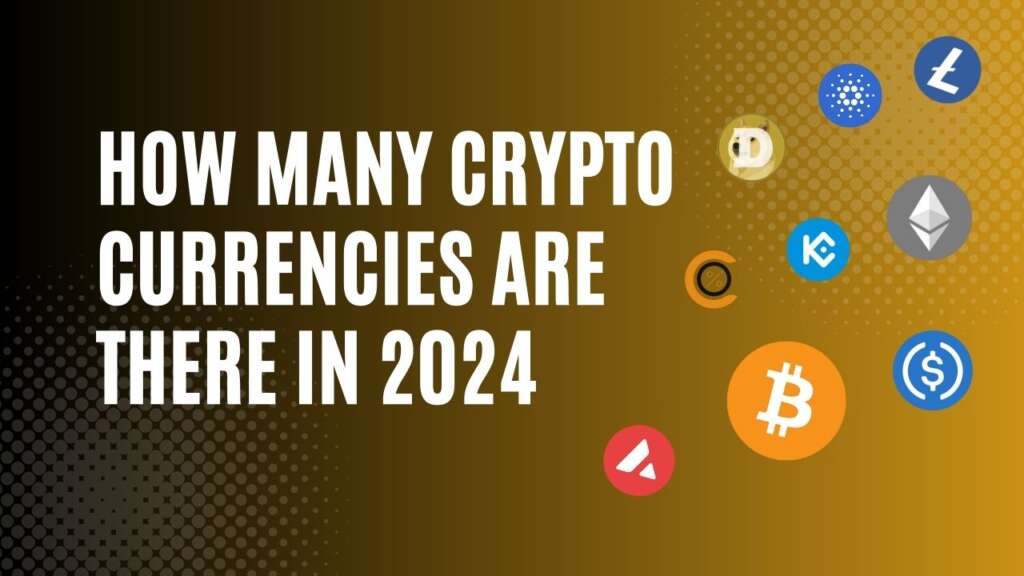The question of “How many cryptocurrencies are there?” sparks curiosity among enthusiasts and investors alike. According to Statista data, there are over 9000 cryptocurrencies found in the market as of 2023 stats. The market cap for all these currencies is around $1.6 trillion as of January 2024.
With numerous digital assets emerging, understanding the diversity within this financial field is crucial. From Bitcoin to altcoins, discover numerous options and much more. Join us on a journey through the numbers and insights that define the expansive world of cryptocurrencies, providing a comprehensive overview for those seeking a deeper understanding of this market.
How Many Cryptocurrencies Are There in 2024?
As of December 2023, the total number of cryptocurrencies reached over 20,000, but it’s essential to note that not all of them hold active or significant value. By excluding numerous inactive or obsolete cryptocurrencies, approximately 9,000 remain active in the market. So we can assume that there are approximately 9000 active cryptocurrencies in the market as we are at the start of 2024.
Number of Cryptocurrencies Growth over Time
In under ten years, cryptocurrency has rapidly emerged, experiencing continuous and rapid expansion. The upcoming segment will showcase its remarkable growth, offering glimpses into the decentralized finance landscape across different timeframes.
Before delving into specific snapshots, let’s provide a brief summary of the cumulative count of legitimate cryptocurrencies spanning from 2013 to the present day:
| Month, Year | Number of Cryptocurrencies |
|---|---|
| January 2013 | 67 |
| January 2014 | 506 |
| January 2015 | 562 |
| January 2016 | 644 |
| January 2017 | 1,335 |
| March 2018 | 1,658 |
| November 2019 | 2,817 |
| February 2021 | 4,501 |
| July 2021 | 6.044 |
| January 2022 | 9,929 |
| February 2023 | 8,685 |
| December 2023 | 8,866 |
* According to Statista Data
Cryptocurrencies Listed on CEXs
Cryptocurrencies form a vast ecosystem, resembling an iceberg with its visible and concealed facets. According to Statista reports, a staggering 20,000 currencies are found on CEXs. However, more than half of them are dead or inactive, with only 8866 active cryptocurrencies on CEXs like Binance, Coin Exchange, OKX and many more.
Famous cryptocurrencies like Bitcoin, Ethereum, Binance Coin, Ripple (XRP), Cardano, Solana, Polkadot, Dogecoin, Litecoin, USDC and numerous more are found on Centralized Exchanges (CEXs), offering a glimpse into the tip of the crypto iceberg. This, however, only scratches the surface.
Beneath lies an expansive undercurrent of on-chain creations, where hundreds, if not thousands, of cryptocurrencies emerge daily.
On-Chain Cryptocurrencies
Prominent blockchain networks like Ethereum, Solana, and Avax facilitate the continuous birth of new tokens. While CEXs and platforms like CoinMarketCap showcase the top cryptocurrencies, the majority remain hidden beneath, symbolizing the extensive diversity and innovation within the decentralized field.
Unlike their CEX-listed counterparts, these on-chain creations remain largely unseen by the majority. Websites like Dextools become essential tools for enthusiasts seeking to explore this submerged realm, allowing them to discover and track many cryptocurrencies not featured on traditional exchanges or market tracking platforms.
This continuous generation reflects the crypto space’s always-changing nature, showcasing its complexity and potential for growth.
Top 10 Most Famous Cryptocurrencies
Following are our top 10 cryptocurrencies guide. From Bitcoin’s pioneering role to Ethereum’s smart contracts, explore the diverse cryptocurrencies that include XRP, Cardano, and many more. Also, find out their latest price according to coinmarketcap stats.
| Rank | Currency | Abbr. | Price |
|---|---|---|---|
| 1 | Bitcoin | BTC | $43,169 |
| 2 | Ethereum | ETH | $2,276 |
| 3 | Tether | USDT | $1 |
| 4 | SOLANA | SOL | $110.58 |
| 5 | BNB | BNB | $264.12 |
| 6 | XRP | XRP | $0.63 |
| 7 | USDC | USDC | $0.99- |
| 8 | CARDANO | ADA | $0.60- |
| 9 | AVALANCHE | AVAX | $46.61- |
| 10 | DOGECOIN | DOGE | $0.092 |
Note: All figures are accurate as of DEC 25, 2023.
1. Bitcoin
Bitcoin (BTC), the pioneering cryptocurrency, remains dominant in the crypto sphere. Created in 2009 by the pseudonymous Satoshi Nakamoto, Bitcoin operates on a decentralized blockchain, ensuring security and transparency. At the time of writing, Bitcoin’s market price stands at $43,110, and it has a market cap of $854.23B, which reflects its position as a leading digital asset.
Its decentralized nature, limited supply, and growing institutional interest have propelled Bitcoin into the mainstream, making it a crucial player in the global financial field. As the first cryptocurrency, Bitcoin sets the standard for many digital currencies that have emerged since its inception.
2. Ethereum
Ethereum (ETH) is a leading cryptocurrency renowned for its smart contract functionality and decentralized applications (DApps). With a current value of $2,276 and a market cap of $273.92B, Ethereum’s significance extends beyond its market value.
Launched in 2015 by Vitalik Buterin, Ethereum allows developers to build and deploy smart contracts on its blockchain, enabling programmable and self-executing agreements.
This versatile platform has catalyzed the creation of various decentralized projects, including decentralized finance (DeFi) applications and non-fungible tokens (NFTs). Ethereum’s ongoing transition to Ethereum 2.0 aims to enhance scalability and sustainability, addressing concerns related to energy consumption.
3. Tether
Tether (USDT) is a prominent cryptocurrency in the market, known for its stability as a stablecoin pegged to the US dollar. Tether remains a crucial player in the crypto space, offering a seamless bridge between traditional and digital assets.
With a fixed value of $1 USDT and a market cap of $91.27B provides a reliable store of value and a widely used trading pair across various crypto exchanges. Its pin to the US dollar enhances liquidity and reduces volatility, making it a favoured choice for traders and investors seeking to minimize exposure to market fluctuations.
4. BNB
Binance Coin (BNB) stands out in the cryptocurrency world as the native token of the Binance exchange. Priced at $264.12, a market cap of $40.47B BNB serves a multi-faceted role within the platform. Initially created as an ERC-20 token on the Ethereum blockchain, Binance Chain replaced ERC-20 as Binance’s native blockchain.
This move enhanced transaction speed and reduced fees for users. BNB holds utility as a means of payment for transaction fees on the exchange, participating in token sales on Binance Launchpad, and even as collateral for decentralized finance (DeFi) applications.
5. Solana
Solana (SOL) stands out as a high-performance blockchain platform in the expansive world of cryptocurrencies. Priced at $110.58 with a market cap of $49.08B SOL has gained significant attention for its lightning-fast transaction speeds and low fees, making it an attractive choice for decentralized applications (DApps) and smart contracts.
Its innovative proof-of-history consensus combined with proof-of-stake ensures scalability without compromising on security. Solana’s ecosystem continues to grow, hosting various projects ranging from decentralized finance (DeFi) platforms to non-fungible tokens (NFTs). Investors are drawn to its potential to revolutionize the blockchain ecosystem., fostering a robust environment for developers and users alike.
6. XRP
Currently, there are thousands of cryptocurrencies, each with unique features and purposes. One prominent player is XRP, valued at $0.63 with a market cap of $34.55B. XRP, created by Ripple Labs, stands out for its focus on facilitating fast and cost-effective cross-border payments.
However, it’s crucial to note that the crypto landscape is highly volatile, with new projects frequently emerging and existing ones changing. Investors navigate this diverse market, considering factors like technology, community support, and real-world applications.
7. USDC
USD Coin (USDC) is a stablecoin pegged to the US dollar, designed to maintain a 1:1 value ratio. Launched in 2018, it has gained widespread adoption in the crypto space. USDC operates on the Ethereum blockchain, ensuring transparency and security.
With a current market value of $1.00 and a market cap of $25.05B, USDC provides stability in a volatile crypto market, making it a popular choice for investors seeking a reliable store of value. Its consistent value is crucial for users engaged in trading or seeking a hedge against crypto market fluctuations.
8. CARDANO
Cardano (ADA) is a prominent cryptocurrency known for its innovative blockchain technology and emphasis on security and sustainability. As of the current market conditions, ADA is priced at $0.614 and has a market cap of $21.63B.
Launched in 2017 by Ethereum co-founder Charles Hoskinson, Cardano provides a secure and scalable platform for developing decentralized applications and smart contracts. It employs a unique consensus algorithm called Ouroboros and is designed to facilitate interoperability between different blockchains.
9. AVALANCHE
Avalanche (AVAX) is a cryptocurrency that operates on the Avalanche platform, known for its high-performance blockchain network. Priced at $47.33 with a market cap of $17.43B AVAX has gained attention for its scalability and sub-second transaction finality.
Launched in September 2020, Avalanche aims to provide a decentralized platform for creating custom blockchain networks and decentralized applications (DApps). AVAX employs the Avalanche consensus protocol, enhancing security and throughput.
10. DOGECOIN
Dogecoin (DOGE) has emerged as a notable player in cryptocurrency, characterized by its Shiba Inu dog logo and a vibrant community. Priced at $0.093 with a market cap of $13.31B Dogecoin has gained popularity for its lighthearted origins and meme-driven culture.
Initially created in 2013, it has since evolved into a legitimate digital asset with a substantial following. Despite its humorous roots, Dogecoin has been embraced for its fast transaction speeds and low fees, making it accessible to a broad user base. Its recent price point reflects market dynamics and the ongoing interest in meme coins.
Top Cryptocurrency Exchanges
Here are the top cryptocurrency exchanges according to coinmarketcap data.
1. Binance
Binance, a leading cryptocurrency exchange, brags a staggering $13,590,978,367 in market capitalization. With a vast market presence spanning 1,460 trading pairs, Binance offers a diverse selection of 395 cryptocurrencies. Its robust platform has become a go-to for traders seeking a wide range of digital assets.
Read our Binance review to learn more.
2. Coinbase
Coinbase, a prominent cryptocurrency exchange, shows off a staggering $1.6 billion valuation and facilitates trading for 241 cryptocurrencies.
With a market presence of 394th, Coinbase has become a pivotal player in the dynamic crypto landscape. The exchange provides users access to diverse digital assets, contributing significantly to the ever-expanding cryptocurrency market.
Read our Coinbase review to learn more.
3. Kraken
Kraken, a prominent cryptocurrency exchange, brags a market capitalization of $762 million, facilitating trades across a diverse array of 779 markets.
With a robust platform supporting 246 different coins, Kraken is a versatile hub for cryptocurrency enthusiasts and investors. The exchange’s extensive market coverage and wide range of supported assets contribute to its prominence in digital currencies.
Read our Kraken review to learn more.
4.KuCoin
KuCoin, a prominent cryptocurrency exchange, shows off a market capitalization of $1 billion. Offering access to a staggering 1,311 cryptocurrencies, KuCoin provides a diverse platform for traders and investors. With 713 trading pairs, the exchange facilitates a broad range of digital asset transactions, contributing to the cryptocurrency market.
Read our Kucoin review to learn more.
5. OKX
OKX, a prominent cryptocurrency exchange with a market capitalization of $2 billion, offers a diverse selection of 616 markets. Boasting a comprehensive range, OKX facilitates the trading of 323 different cryptocurrencies.
As a significant player in the crypto space, it provides users ample opportunities to engage in trading activities, reflecting the expansive nature of the cryptocurrency market.
Read our OKX review to learn more.
| CMC Rank | Exchange | 24hr Trading Volume | Markets | Coins |
|---|---|---|---|---|
| 1 | Binance | $13 Billion | 1,460 | 395 |
| 2 | Coinbase | $1,6 Billion | 394 | 241 |
| 3 | Kraken | $762 Million | 779 | 246 |
| 4 | KuCoin | $1 Billion | 1311 | 713 |
| 5 | OKX | $2 Billion | 616 | 323
|
Bottom Line
Cryptocurrencies are continually expanding, now comprising numerous digital assets. This diversity offers both opportunities and challenges for investors. Staying updated on market trends and emerging coins and understanding the factors driving cryptocurrency spread is crucial for navigating the always-developing financial ecosystem.
FAQs
How has the number of cryptocurrencies evolved over the past year?
Over the past year, the cryptocurrency landscape has witnessed dynamic growth, with the number of cryptocurrencies steadily increasing. New projects and tokens regularly enter the market, reflecting ongoing innovation and interest.
What factors contribute to the continuous growth of new cryptocurrencies?
The continuous growth of new cryptocurrencies can be attributed to technological innovation, decentralized finance (DeFi) trends, and the desire for alternative investment opportunities.
How does the total number of cryptocurrencies impact the overall cryptocurrency market?
The total number of cryptocurrencies significantly impacts the overall cryptocurrency market by influencing market dynamics, investor sentiment, and regulatory considerations. A higher number can offer diversification but also pose challenges, including increased competition, liquidity issues, and the need for robust vetting mechanisms.
Are all cryptocurrencies actively traded on major exchanges?
No, not all cryptocurrencies are actively traded on major exchanges. While popular coins like Bitcoin and Ethereum dominate trading platforms, numerous smaller or newer cryptocurrencies may have limited liquidity and may not be listed on major exchanges.
How can one keep track of the latest additions to the cryptocurrency market?
Staying informed about the latest additions to the cryptocurrency market involves regularly monitoring reputable cryptocurrency news websites, subscribing to newsletters, and utilizing dedicated tracking platforms like CoinMarketCap or CoinGecko.




![How to Withdraw funds from MetaMask [2024]](https://www.cryptowinrate.com/wp-content/uploads/2024/06/Add-a-little-bit-of-body-text-1024x597.jpg)













